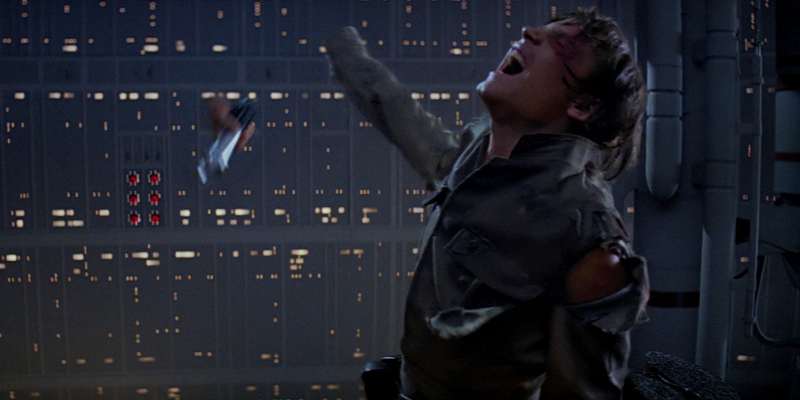Who is Star Wars for? It’s a question that’s been heavily contested for some time, increasingly complicated as more branches shoot off from what was originally just a campy, indie homage to Flash Gordon. Is it truly for the die-hard fans who can speak its constructed languages and fact-check the fiction better than Lucasfilm’s Story Group? Is it first and foremost for the casual filmgoers, who don’t care about all the books, games, and TV shows? Most importantly, is it a franchise for kids or adults?
The George Lucas era of Star Wars was awkwardly juxtaposed between being for younger and older audiences. The film franchise is overtly chaste about romance, scarcely even permitting kisses. On the other hand, brutally slicing arms off a sentient being is treated casually as far back as A New Hope. There’s an ongoing religious war between the Jedi and Sith, yet spirituality is rarely explored in the setting, especially the Eastern religions Lucas drew upon when creating the denominations and The Force. There are chipper little robots that beep and boop and mass slaughter of children.
This conflicting idea of who the series appeals to extended into the Expanded Universe, where, over time, new novels, comics, and games inched closer and closer to being for more mature audiences. Republic, Legacy, Dark Times, and Agent of the Empire grew increasingly daring about sexuality, drugs, and the psychological toll of the near-constant state of actual Star Wars. The New Jedi Order novels focused precisely on following an entire war beat for beat, killing off mainline characters as the galaxy faced a far worse enemy than the Empire — even going so far as to have the Empire reform and ally with the New Republic to stem the tide of the Yuuzhan Vong invasion.
Yet at the same time, projects like Bombad Racing, The Clone Wars CGI TV show, and numerous all-ages projects rolled off the presses. Lego Star Wars was one of the franchise’s biggest successes. This demonstrates how Star Wars outside of film can appeal to various groups. A show on Cartoon Network might be more careful at times with how brutal it could get, but a Dark Horse comic was free to depict bleaker moments. A child wasn’t likely to follow the more serious New Jedi Order books when Junior Jedi Knights was far more palatable.

While the games varied a fair bit more, you can clearly see how they delineate between projects meant for younger and older players. Jedi Knight and Battlefront were obvious for teens and adults, where the likes of Episode One: Racer and Pit Droids stayed within the realm of family-friendly fun. Their key priority was that, no matter what was going on, the two sectors stayed out of each other’s way. Instead of weakening the integrity or creative freedom of the setting, it was all weaved together as cohesive — with just enough isolation for each material to exist on its own if it didn’t appeal to you.
This all changed when The Clone Wars was granted a canonical level on par with the films. A series meant for children suddenly had greater say than any other property, no matter the popularity with the fanbase. As has been discussed on The Escapist Movie Podcast — this led to several moments of drama and chagrin for the series. When Disney bought Lucasfilm, its decision to ensure everything was canon and heavily cross-branded only served to exacerbate this problem of tying down everything to the safest common denominator.
Even the work of Dave Filoni, the man behind The Clone Wars, demonstrates this through his successor series, Rebels. Rebels tries to feature the horrors of war but is vastly more toothless, awkwardly avoiding certain violent moments with dramatic cuts, while others are left clear and pointed. Yet the show displays Inquisitors flying through the air with their lightsabers like evil Mary Poppins without any hesitation.
Over time this has evolved from an unspoken rule to an outright excuse, with some going so far as to spout, “It’s for kids!” as if that’s somehow a defense for the inconsistent quality. If Star Wars is for kids, then someone clearly forgot to mention that to some of the franchise’s creators. Star Wars Jedi: Fallen Order has some rather worrying elements like white savior and ethnic genocide tropes. However, cutting off stormtroopers’ arms, something already seen in other Star Wars media time and again, was apparently where Lucasfilm drew the line. So it’s okay to potentially teach outdated, racist ideas to kids, but not to let Cal Kestis’ lightsaber work like Rey’s did in The Last Jedi? It’s not a ratings board issue — otherwise The Force Unleashed II would’ve been rated M for mature. This is “Han shot second” levels of moral justification.

This point is ironically made all the more obvious given most of the all-ages Star Wars media is more daring than the mainline adult material. Where many found Finn short-served by his arc over the sequel trilogy, The Freemaker Chronicles depicts a heartwarming interracial family, each with their own individual arcs, without skipping a beat. IDW’s Star Wars Adventures all-ages line has a story where Luke and Leia touch on how Leia’s holding up under the weight of all her emotional trauma. A Test of Courage grapples with headier personal problems than the adult-aimed book it’s supposed to accompany. Kieron Gillen’s Chelli Aphra is one of the first openly gay characters in the new timeline, while The Rise of Skywalker actively hides its singular queer kiss in the background of a major scene — and censored it in certain regions.
I’m not saying that Star Wars has to be explicitly for adults, but the franchise needs to either commit or split itself as it did in the past. Kids know when they’re being talked down to, and Disney should know that given it’s overseen the production of Gravity Falls, Tangled: The Series, and The Owlhouse — all of which have dealt with everything from LGBTQ+ representation to criminal and social justice to delving into outright horror stories. And they’ve all done exceptionally better jobs of maintaining coherent, enjoyable, well-written storylines than Star Wars has since 2013. If made-for-TV kids shows can offer more compelling, cohesive stories than one of the biggest franchises on the planet, why bother consuming the latter?
If Star Wars is for kids, then the kids deserve better, and the same goes for adults. All these half-measures are strangling the franchise’s potential. All Disney needs to do is either loosen the reins and push both demographics into their own spheres, or choose a direction. I don’t care if Star Wars becomes a thing for the next generation, but I do care about it actually being a quality work of fiction for them. I grew up with some spectacular stories from the Star Wars setting. The people working on the newest Star Wars adventures know we can do better than some of what’s been propped up and excused for. The franchise needs to either grow up like it was going to with 1313 or own up to its own defense and do right by the kids experiencing it now. Do or do not, Lucasfilm. There is no try.
